Search
- Page Path
-
- HOME
- Search
- Review Article
- Cardiology
- Heart failure in children and adolescents: an update on diagnostic approaches and management
- Amit Agrawal, Dalwinder Janjua, Abdulrahman Ahmed Alsayed Ali Zeyada, Ahmed Taher Elsheikh
- Clin Exp Pediatr. 2024;67(4):178-190. Published online June 19, 2023
-
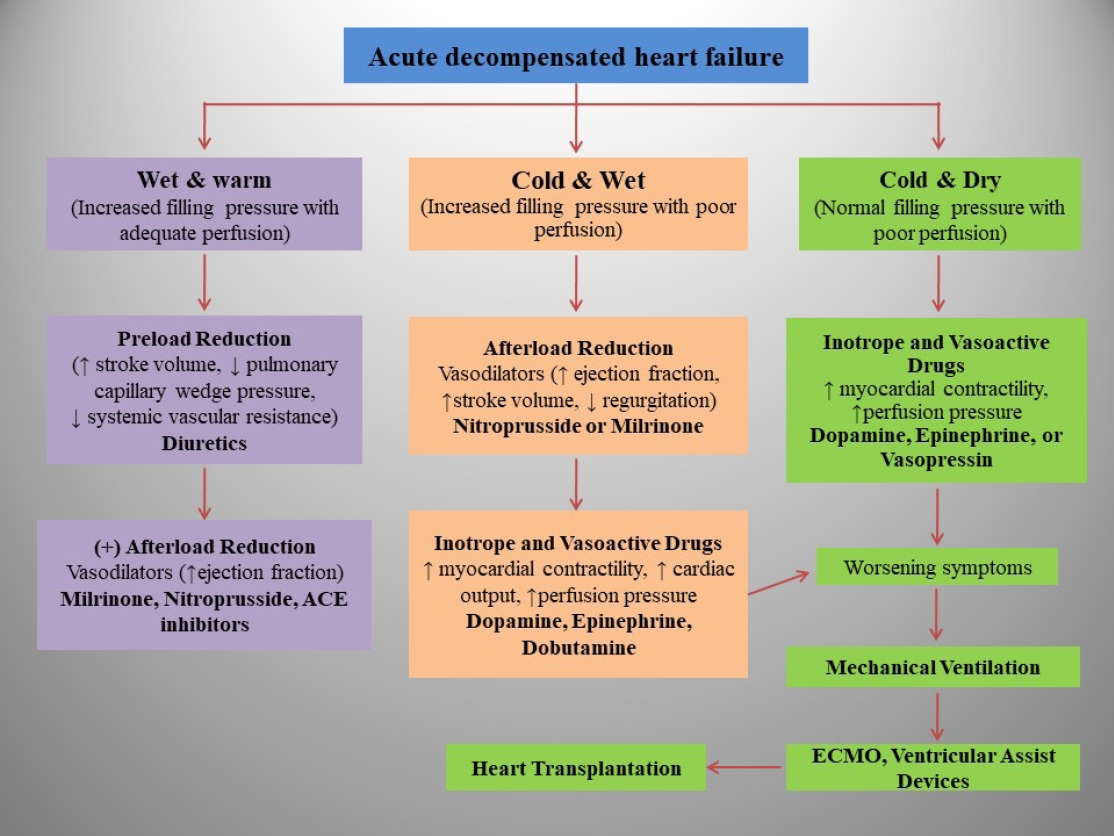
· Pediatric heart failure (PHF) is a clinical syndrome featuring various symptoms (shortness of breath, ankle swelling, fatigue) and signs (pulmonary crackles, peripheral edema).
· Congenital heart diseases are the most common underlying etiology of PHF, whereas myocarditis and primary cardio-myopathies are common in children without structural ab-normalities.
· PHF pathophysiology is complex and multifactorial and varies by etiology and age.
· PHF management includes decongestive therapy, treatment of underlying causes, preventing progression, and managing pulmonary or systemic obstructions.
· Drugs should be chosen based on pharmacodynamics, clinical manifestations, hemodynamic state, and renal function.
- Environmental changes surrounding congenital heart disease
- Eun-Young Choi
- Clin Exp Pediatr. 2023;66(8):332-338. Published online January 2, 2023
-
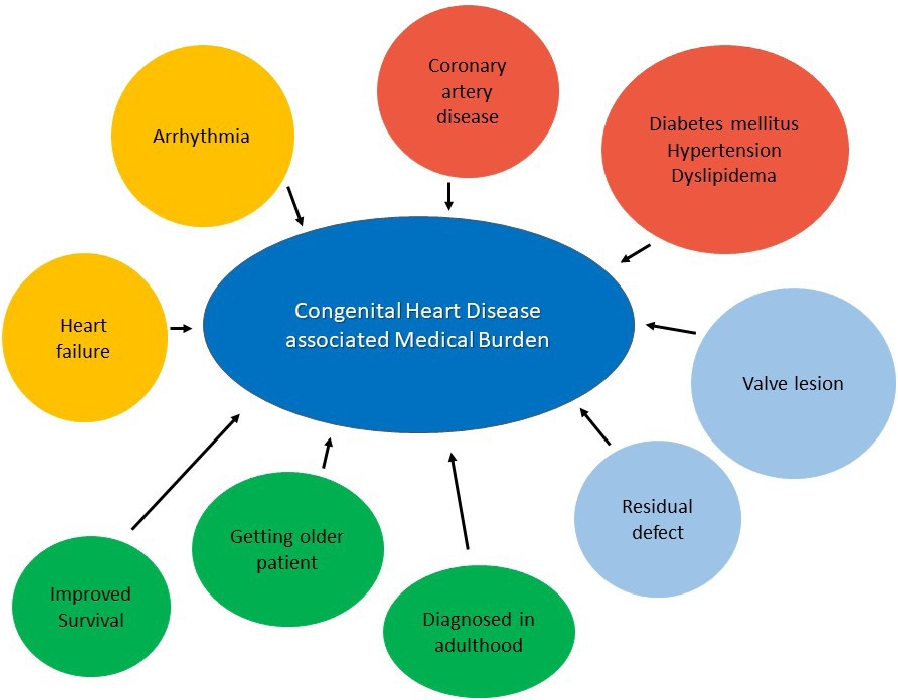
· As the number of patients with congenital heart disease increases, the medical burden increases.
· Various fusion imaging techniques using percutaneous procedures have been introduced.
· With advances in technology, convenient ambulatory devices have been introduced.
· A well-organized team approach is required to resolve advanced heart failure in patients with congenital heart disease.
- Implication of microRNA as a potential biomarker of myocarditis
- Jin-Hee Oh, Gi Beom Kim, Heeyoung Seok
- Clin Exp Pediatr. 2022;65(5):230-238. Published online March 2, 2022
-

· Myocarditis was recently examined quantitatively as inflammation of the heart muscle based on endomyocardial biopsy, and its noninvasive diagnosis remains unsatisfactory.
· Additionally, numerous miRNAs (miR-155, miR-146b, miR-590, miR-221, miR-222, etc.) coupled with inflammation or viral activation have been examined in myocarditis patients or mouse models.
· The recent identification of mmu-miR-721 (has-miR-Chr8: 96), a myocarditis-specific microRNA, demonstrated its potential as an acute myocarditis biomarker.
- Application of CRISPR-Cas9 gene editing for congenital heart disease
- Heeyoung Seok, Rui Deng, Douglas B. Cowan, Da-Zhi Wang
- Clin Exp Pediatr. 2021;64(6):269-279. Published online March 2, 2021
-
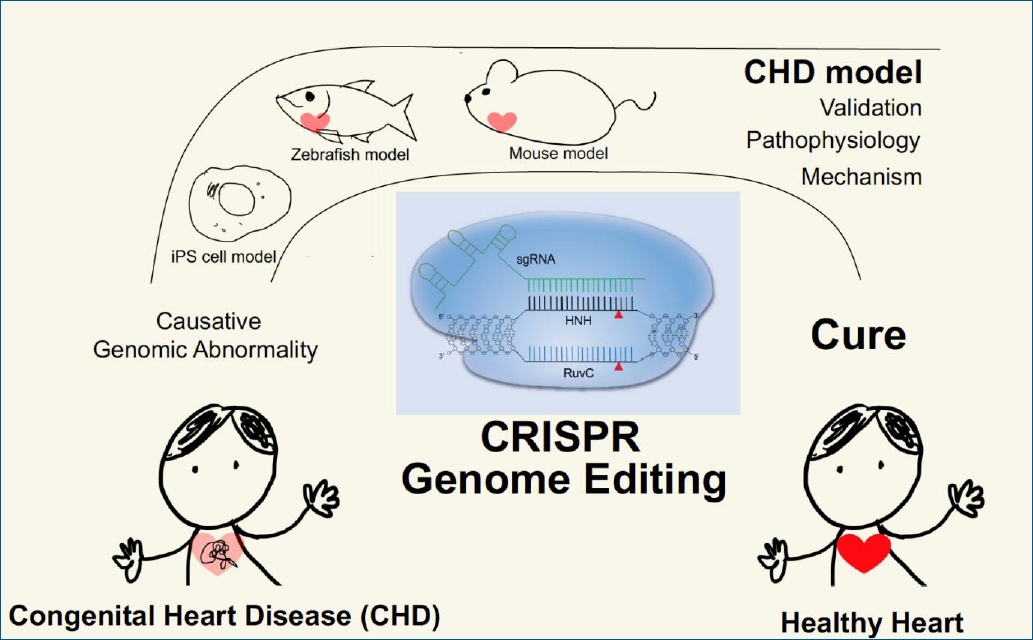
Clustered regularly interspaced short palindromic repeats and CRISPR-associated protein 9 (CRISPR-Cas9) system has made a big step in the genome editing which still requires technical developments for the efficient applications in the many fields including congenital heart diseases (CHDs), closely related to the genomic abnormality. In this review, we tried to cover the most updated researches of CRISPR-Cas9 in the CHDs to understand the current technologies, eventually becoming therapeutic bases for the CHD patients.
- Original Article
- Neonatology (Perinatology)
- New modified version of the Risk Adjustment for Congenital Heart Surgery category and mortality in premature infants with critical congenital heart disease
- Young Mi Yoon, Seong Phil Bae, Yoon-Joo Kim, Jae Gun Kwak, Woong-Han Kim, Mi Kyoung Song, Seung Han Shin, Ee-Kyung Kim, Han-Suk Kim
- Clin Exp Pediatr. 2020;63(10):395-401. Published online July 15, 2020
-

Questions: This study aimed to describe the survival of premature infants with critical congenital heart disease (CHD) and to identify the risk factors including the new modified version of the Risk Adjustment for Congenital Heart Surgery (M-RACHS) associated with mortality.
Finding: For premature infants with critical CHD, survival rate was 76.9% and very low birth weight (VLBW), persistent pulmonary hypertension of the newborn (PPHN), bronchopulmonary dysplasia (BPD), and M-RACHS 5 or more were associated with in-hospital mortality.
Meaning: VLBW, PPHN and BPD, as well as M-RACHS≥5, were risk factors for mortality among premature infants with critical CHD.
- Review Article
- Cardiology
- Pediatric heart transplantation: how to manage problems affecting long-term outcomes?
- Young Hwue Kim
- Clin Exp Pediatr. 2021;64(2):49-59. Published online April 8, 2020
-
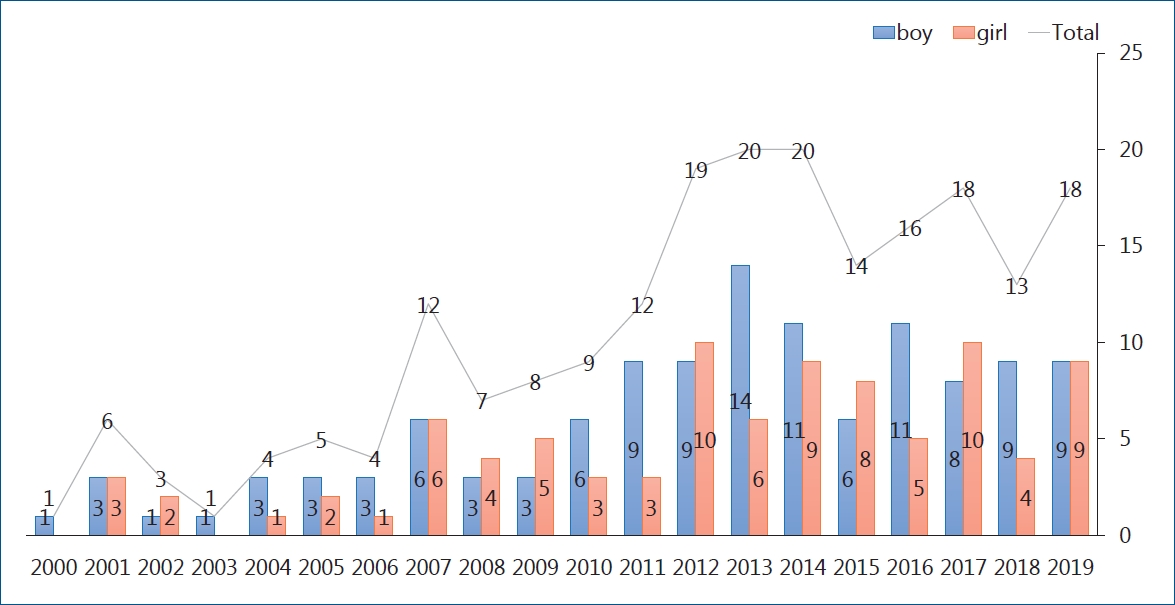
Since the initial International Society of Heart Lung Transplantation registry was published in 1982, the number of pediatric heart transplantations has increased markedly, reaching a steady state of 500–550 transplantation annually and occupying up to 10% of total heart transplantations. Heart transplantation is considered an established therapeutic option for patients with end-stage heart disease. The long-term outcomes of pediatric heart...
- Original Article
- Cardiology
- The change of QRS duration after pulmonary valve replacement in patients with repaired tetralogy of Fallot and pulmonary regurgitation
- Yuni Yun, Yeo Hyang Kim, Jung Eun Kwon
- Clin Exp Pediatr. 2018;61(11):362-365. Published online October 24, 2018
-
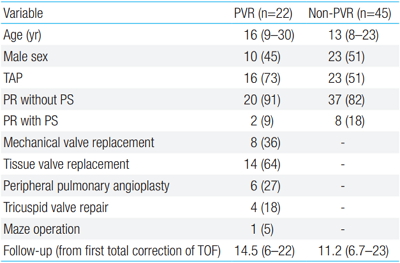
Purpose: This study aimed to analyze changes in QRS duration and cardiothoracic ratio (CTR) following pulmonary valve replacement (PVR) in patients with tetralogy of Fallot (TOF). Methods: Children and adolescents who had previously undergone total repair for TOF (n=67; median age, 16 years) who required elective PVR for pulmonary regurgitation and/or right ventricular out tract obstruction were included in this study....
- Outcomes of transcatheter closure of ductus arteriosus in infants less than 6 months of age: a single-center experience
- Gwang-Jun Choi, Jinyoung Song, Yi-Seul Kim, Heirim Lee, June Huh, I-Seok Kang
- Clin Exp Pediatr. 2018;61(12):397-402. Published online September 19, 2018
-

Purpose: Transcatheter device closure of patent ductus arteriosus (PDA) is challenging in early infancy. We evaluated PDA closure in infants less than 6 months old. Methods: We performed a retrospective review of infants less than 6 months of age who underwent attempted transcatheter device closure in our institution since 2004. To compare clinical outcomes between age groups, infants aged 6–12 months...
- Neonatology (Perinatology)
- Evaluation of prolonged pain in preterm infants with pneumothorax using heart rate variability analysis and EDIN (Échelle Douleur Inconfort Nouveau-Né, neonatal pain and discomfort scale) scores
- Mehmet Buyuktiryaki, Nurdan Uras, Nilufer Okur, Mehmet Yekta Oncel, Gulsum Kadioglu Simsek, Sehribanu Ozluer Isik, Serife Suna Oguz
- Clin Exp Pediatr. 2018;61(10):322-326. Published online September 16, 2018
-
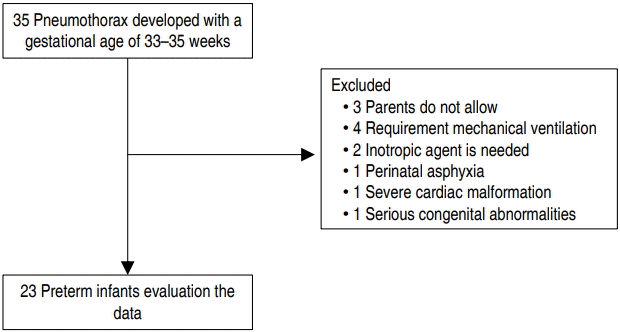
Purpose: The EDIN scale (Échelle Douleur Inconfort Nouveau-Né, neonatal pain and discomfort scale) and heart rate variability has been used for the evaluation of prolonged pain. The aim of our study was to assess the value of the newborn infant parasympathetic evaluation (NIPE) index and EDIN scale for the evaluation of prolonged pain in preterm infants with chest tube placement...
- Cardiology
- The outcome of percutaneous stent implantation in congenital heart disease: experience of a single institute
- Moon Sun Kim, Ja Kyoung Yoon, Seong Ho Kim, Ji Seok Bang, So Ick Jang, Sang Yoon Lee, Eun Young Choi, Su Jin Park, Hye Won Kwon
- Clin Exp Pediatr. 2018;61(6):187-193. Published online June 25, 2018
-

Purpose The efficacy of percutaneous stent implantation for congenital heart disease (CHD) in Korea, where stent availability is limited, has not been determined. This study evaluated the acute and midterm results of stent implantation in different CHD subgroups.
Methods Stents were implanted in 75 patients with 81 lesions: (1) pulmonary artery stenosis (PAS) group, 56 lesions in 51 patients; (2) coarctation of the...
- General Pediatrics
- Sudden unexpected cardio-respiratory arrest after venipuncture in children
- Goun Jeong, Son Moon Shin, Nam Su Kim, Young Min Ahn
- Clin Exp Pediatr. 2018;61(4):108-113. Published online April 23, 2018
-
Purpose This study aimed to investigate the clinical and socioenvironmental characteristics of sudden cardiorespiratory arrest after venipuncture in children.
Methods We conducted a retrospective email-based survey of all members of the Korean Pediatric Society. The questionnaire included items on patient demographics, socioenvironmental circumstances of the venipuncture, type of cardiorespiratory arrest, symptoms and signs, treatment, prognosis, and presumed cause of the arrest.
Results Fourteen patients were...
- Review Article
- Cardiology
- Recent advances in pediatric interventional cardiology
- Seong-Ho Kim
- Clin Exp Pediatr. 2017;60(8):237-244. Published online August 14, 2017
-
During the last 10 years, there have been major technological achievements in pediatric interventional cardiology. In addition, there have been several advances in cardiac imaging, especially in 3-dimensional imaging of echocardiography, computed tomography, magnetic resonance imaging, and cineangiography. Therefore, more types of congenital heart diseases can be treated in the cardiac catheter laboratory today than ever before. Furthermore, lesions previously...
- Original Article
- Cardiology
- Impact of postoperative duration of Aspirin use on longevity of bioprosthetic pulmonary valve in patients who underwent congenital heart disease repair
- Tae-Woong Hwang, Sung-Ook Kim, Sang-Yun Lee, Seong-Ho Kim, Eun-Young Choi, So-Ick Jang, Su-Jin Park, Hye-Won Kwon, Hyo-Bin Lim, Chang-Ha Lee, Eun-Seok Choi
- Clin Exp Pediatr. 2016;59(11):446-450. Published online November 18, 2016
-
Purpose Generally, aspirin is used as a protective agent against thrombogenic phenomenon after pulmonary valve replacement (PVR) using a bioprosthetic valve. However, the appropriate duration of aspirin use is unclear. We analyzed the impact of postoperative duration of aspirin use on the longevity of bioprosthetic pulmonary valves in patients who underwent repair for congenital heart diseases.
Methods We retrospectively reviewed the clinical data...
- The strong association of left-side heart anomalies with Kabuki syndrome
- Ja Kyoung Yoon, Kyung Jin Ahn, Bo Sang Kwon, Gi Beom Kim, Eun Jung Bae, Chung Il Noh, Jung Min Ko
- Clin Exp Pediatr. 2015;58(7):256-262. Published online July 22, 2015
-
Purpose Kabuki syndrome is a multiple congenital malformation syndrome, with characteristic facial features, mental retardation, and skeletal and congenital heart anomalies. However, the cardiac anomalies are not well described in the Korean population. We analyzed the cardiac anomalies and clinical features of Kabuki syndrome in a single tertiary center.
Methods A retrospective analysis was conducted for a total of 13 patients with Kabuki...
- Review Article
- Comprehensive understanding of atrial septal defects by imaging studies for successful transcatheter closure
- Jinyoung Song
- Clin Exp Pediatr. 2014;57(7):297-303. Published online July 23, 2014
-
Transcatheter closure of atrial septal defects has become a popular procedure. The availability of a preprocedural imaging study is crucial for a safe and successful closure. Both the anatomy and morphology of the defect should be precisely evaluated before the procedure. Three-dimensional (3D) echocardiography and cardiac computed tomography are helpful for understanding the morphology of a defect, which is important...
- Psychosocial adjustment and quality of life of adolescents and adults with congenital heart disease
- Gi Beom Kim
- Clin Exp Pediatr. 2014;57(6):257-263. Published online June 30, 2014
-
The incidence of people living with congenital heart disease (CHD) has been increasing every year owing to remarkable advances in surgical and catheter intervention techniques and devices, and improved knowledge of critical care for patients with CHD. However, these patients continue to face physical, psychosocial, and environmental challenges, and a number of studies have shown higher rates of depression and...
- Original Article
- Outcome of inflammatory response after normothermia during cardiopulmonary bypass surgery in infants with isolated ventricular septal defect
- Dong Sub Kim, Sang In Lee, Sang Bum Lee, Myung Chul Hyun, Joon Yong Cho, Young Ok Lee
- Clin Exp Pediatr. 2014;57(5):222-225. Published online May 31, 2014
-
Purpose A recent study analyzing several cytokines reported that long cardiopulmonary bypass (CPB) time and long aortic cross clamp (ACC) time were accompanied by enhanced postoperative inflammation, which contrasted with the modest influence of the degree of hypothermia. In this present study, we aimed to examine the effect of CPB temperature on the clinical outcome in infants undergoing repair of isolated...
- Baseline heart rate variability in children and adolescents with vasovagal syncope
- Sun Hee Shim, Sun-Young Park, Se Na Moon, Jin Hee Oh, Jae Young Lee, Hyun Hee Kim, Ji Whan Han, Soon Ju Lee
- Clin Exp Pediatr. 2014;57(4):193-198. Published online April 30, 2014
-
Purpose This study aimed to evaluate the autonomic imbalance in syncope by comparing the baseline heart rate variability (HRV) between healthy children and those with vasovagal syncope.
Methods To characterize the autonomic profile in children experiencing vasovagal syncope, we evaluated the HRV of 23 patients aged 7-18 years and 20 healthy children. These children were divided into preadolescent (<12 years) and adolescent groups....
- Review Article
- Pulmonary stenosis and pulmonary regurgitation: both ends of the spectrum in residual hemodynamic impairment after tetralogy of Fallot repair
- Byung Won Yoo, Han Ki Park
- Clin Exp Pediatr. 2013;56(6):235-241. Published online June 21, 2013
-
Repair of tetralogy of Fallot (TOF) has shown excellent outcomes. However it leaves varying degrees of residual hemodynamic impairment, with severe pulmonary stenosis (PS) and free pulmonary regurgitation (PR) at both ends of the spectrum. Since the 1980s, studies evaluating late outcomes after TOF repair revealed the adverse impacts of residual chronic PR on RV volume and function; thus, a...
- Original Article
- Implantable cardioverter defibrillator therapy in pediatric and congenital heart disease patients: a single tertiary center experience in Korea
- Bo Kyung Jin, Ji Seok Bang, Eun Young Choi, Gi Beom Kim, Bo Sang Kwon, Eun Jung Bae, Chung Il Noh, Jung Yun Choi, Woong Han Kim
- Clin Exp Pediatr. 2013;56(3):125-129. Published online March 18, 2013
-
Purpose The use of implantable cardioverter defibrillators (ICDs) to prevent sudden cardiac death is increasing in children and adolescents. This study investigated the use of ICDs in children with congenital heart disease.
Methods This retrospective study was conducted on the clinical characteristics and effectiveness of ICD implantation at the department of pediatrics of a single tertiary center between 2007 and 2011.
Results Fifteen patients underwent...
- Review Article
- Right ventricular failure in congenital heart disease
- Young Kuk Cho, Jae Sook Ma
- Clin Exp Pediatr. 2013;56(3):101-106. Published online March 18, 2013
-
Despite developments in surgical techniques and other interventions, right ventricular (RV) failure remains an important clinical problem in several congenital heart diseases (CHD). RV function is one of the most important predictors of mortality and morbidity in patients with CHD. RV failure is a progressive disorder that begins with myocardial injury or stress, neurohormonal activation, cytokine activation, altered gene expression,...
- Original Article
- Recent incidence of congenital heart disease in neonatal care unit of secondary medical center: a single center study
- Seon Young Cho, Jin-Hee Oh, Jung Hyun Lee, Jae Young Lee, Soon Ju Lee, Ji Whan Han, Dae Kyun Koh, Chang Kyu Oh
- Clin Exp Pediatr. 2012;55(7):232-237. Published online July 17, 2012
-
Purpose With feasibility in the diagnoses of congenital heart disease (CHD) in the antenatal period, we suspect changes have occurred in its incidence. No data have been reported about the current incidence of simple forms of CHD in Korea. We have attempted to assess the recent incidence and characteristics of CHD in the neonatal care unit of a secondary referral medical...
- Case Report
- Partial anomalous pulmonary venous connection with intact atrial septum in a child with ventricular septal defect: a case report
- Young Nam Kim, Hwa Jin Cho, Young Kuk Cho, Jae Sook Ma
- Clin Exp Pediatr. 2012;55(1):24-28. Published online January 31, 2012
-
Partial anomalous pulmonary vein connection (PAPVC) is a rare congenital abnormal cardiac defect involving the pulmonary veins draining into the right atrium (RA) directly or indirectly by venous connection. Ninety percent of PAPVCs are accompanied by atrial septal defect (ASD). To our knowledge, there is no previous report of PAPVC with ventricular septal defect (VSD) without ASD in Korea, and...
- Review Article
- Respiratory syncytial virus prevention in children with congenital heart disease: who and how?
- Nam Kyun Kim, Jae Young Choi
- Clin Exp Pediatr. 2011;54(5):197-200. Published online May 31, 2011
-
Respiratory syncytial virus (RSV) is a major cause of respiratory infection in children. Most of the pediatric population have RSV infection before the age of 2, and recurrent infections are common even within one season. Chronic lung disease, prematurity, along with congenital heart disease (CHD) are major risk factors in severe lower respiratory infection. In hemo-dynamically significant CHD patients with...
- Respiratory syncytial virus infection in children with congenital heart disease: global data and interim results of Korean RSV-CHD survey
- Jo Won Jung
- Clin Exp Pediatr. 2011;54(5):192-196. Published online May 31, 2011
-
Respiratory syncytial virus (RSV) is a main cause of hospitalization for bronchiolitis and pneumonia in infants worldwide. Children with hemodynamically significant congenital heart disease (HS-CHD), as well as premature infants are at high risk for severe RSV diseases. Mortality rates for CHD patients hospitalized with RSV have been reported as about 24 times higher compared with those without RSV infection....
- Congenital heart disease in the newborn requiring early intervention
- Sin Weon Yun
- Clin Exp Pediatr. 2011;54(5):183-191. Published online May 31, 2011
-
Although antenatal diagnostic technique has considerably improved, precise detection and proper management of the neonate with congenital heart disease (CHD) is always a great concern to pediatricians. Congenital cardiac malformations vary from benign to serious conditions such as complete transposition of the great arteries (TGA), critical pulmonary and aortic valvular stenosis/atresia, hypoplastic left heart syndrome (HLHS), obstructed total anomalous pulmonary...
- Practical stepwise approach to rhythm disturbances in congenital heart diseases
- June Huh
- Clin Exp Pediatr. 2010;53(6):680-687. Published online June 23, 2010
-
Patients with congenital heart diseases (CHD) are confronted with early- and late-onset complications, such as conduction disorders, arrhythmias, myocardial dysfunction, altered coronary flow, and ischemia, throughout their lifetime despite successful hemodynamic and/or anatomical correction. Rhythm disturbance is a well-known and increasingly frequent cause of morbidity and mortality in patients with CHD. Predisposing factors to rhythm disturbances include underlying cardiac defects,...
- Clinical presentations of critical cardiac defects in the newborn: Decision making and initial management
- Jae Young Lee
- Clin Exp Pediatr. 2010;53(6):669-679. Published online June 23, 2010
-
The risk of mortality and morbidity of patients with congenital heart defects (CHDs) is highest during neonatal period and increases when diagnosis and proper management are delayed. Neonates with critical CHDs may present with severe cyanosis, respiratory distress, shock, or collapse, all of which are also frequent clinical presentations of various respiratory problems or sepsis in the newborn. Early diagnosis...
- Original Article
- Electrocardiography as an early cardiac screening test in children with mitochondrial disease
- Ran Baik, Jung Hyun Chae, Young Mock Lee, Hoon Chul Kang, Joon Soo Lee, Heung Dong Kim
- Clin Exp Pediatr. 2010;53(5):644-647. Published online May 31, 2010
-
Purpose To evaluate myocardial conductivity to understand cardiac involvement in patients with mitochondrial disease.
Methods We performed retrospective study on fifty-seven nonspecific mitochondrial encephalopathy patients with no clinical cardiac manifestations. The patients were diagnosed with mitochondrial respiratory chain complex defects through biochemical enzyme assays of muscle tissue. We performed standard 12-lead electrocardiography (ECG) on all patients.
Results ECG abnormalities were observed in 30 patients (52.6%)....
- Early postoperative arrhythmias after open heart surgery of pediatric congenital heart diseas
- Hee Joung Choi, Yeo Hyang Kim, Joon Yong Cho, Myung Chul Hyun, Sang Bum Lee, Kyu Tae Kim
- Clin Exp Pediatr. 2010;53(4):532-537. Published online April 15, 2010
-
Purpose : Early postoperative arrhythmias are a major cause of mortality and morbidity after open heart surgery in the pediatric population. We evaluated the incidence and risk factors of early postoperative arrhythmias after surgery of congenital heart disease. Methods : From January 2002 to December 2008, we retrospectively reviewed the medical records of the 561 patients who underwent cardiac surgery in Kyungpook National University... -
-

-
-

-

-
Impact Factor4.2
-
6.52022CiteScore92nd percentilePowered by







